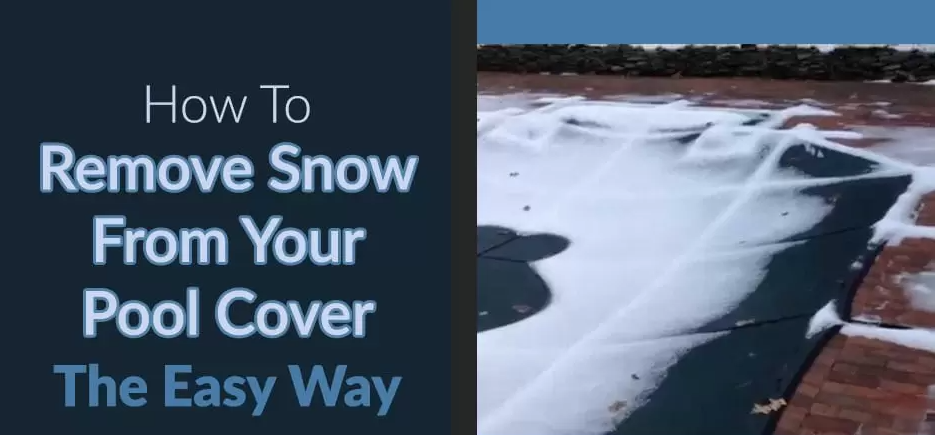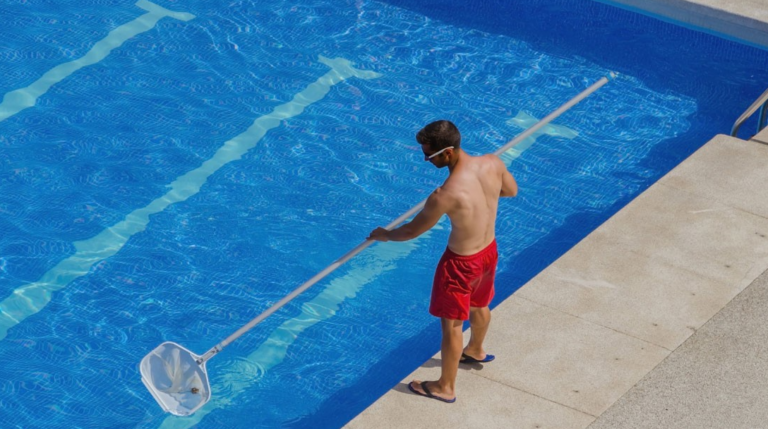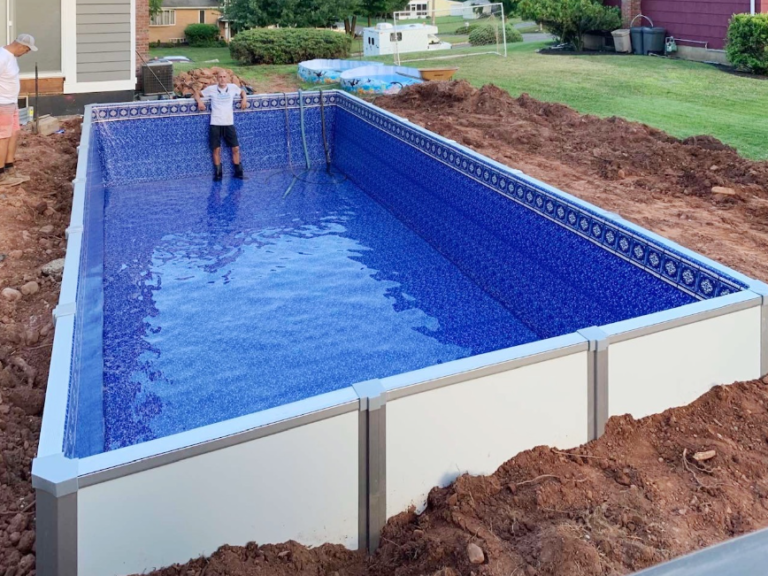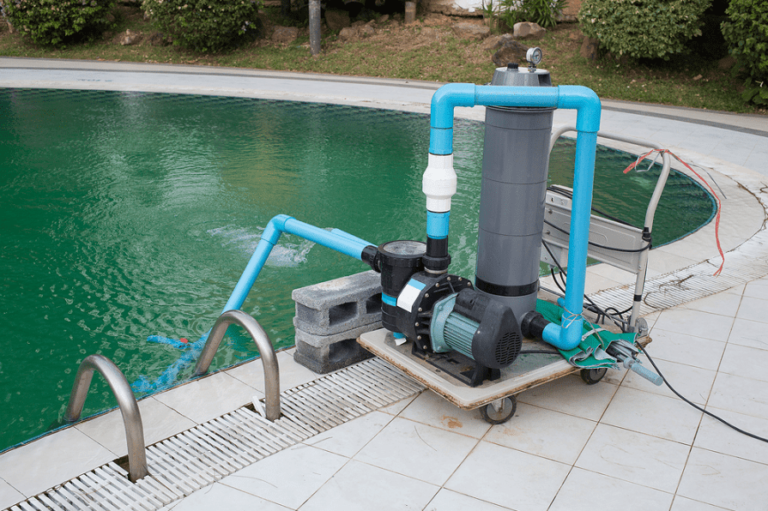Pool cover snow removal tool:
What happens to snow and ice on pool covers?
If you have an above-ground swimming pool, you may be surprised to learn that your primary concern is not that snow may damage your pool cover. As mentioned above, it is the weight of the snow that matters. This can cause your core to bend in the middle, creating pressure. Bending pressure can cause the cover to pull on your pool walls, potentially damaging your swimming pool’s top rail, fence, and walls.
Worst case scenario: Your pool could collapse on its own! This is an extreme situation, but one we want to help you avoid.
If you live in an area that gets a lot of snow, you will have to deal with the accumulation of snow on your pool cover. It might not seem like that big of a deal—it’s going to melt eventually, right? Well, yes, but in the meantime, it can actually cause a lot of damage to your pool cover. And if you have an above ground pool, too much snow on the cover can damage the pool.
It is easily treated. You just need to have the right pool cover snow removal tools on hand, and take action before any damage is done.
If you live in the Northeast, or anywhere that experiences snowy winters, keep reading. Because removing snow from your pool cover is something you’ve either dealt with before or will deal with soon.
So today, we’re sharing a few tips for dealing with snow on your pool cover. Small strategies that make things easier.
If you want to avoid damaging your cover, or worse, replace it entirely, follow the tips in this post. They will save you time, frustration and make keeping snow off your pool cover much easier.
You’ve added an air cushion to your swimming pool, cleaned it and covered it. You’re ready for the freezing weather, you’re sure your pool’s winterization is done, and you’re sure it won’t be until Memorial Day next year that you think about pool maintenance again. Will not have to.

I’m sorry to burst your bubble! If your area gets a lot of snow, you’ll need to look into how to remove snow from pool covers. Don’t let the weight of snow combined with freezing temperatures destroy your pool cover or damage the pool itself.
Why remove snow from pool covers?
Have you ever been to the beach? Maybe you have a little sand on your legs or arms, but you don’t even notice because only a few grains are seemingly weightless.
Now, have you ever been buried in the sand at the beach? The sand was quite heavy on your body, wasn’t it? You may still be able to move but without difficulty.
The same is true of snow. One or two flakes are nothing. But the coexistence of millions and millions eventually becomes overwhelming.
If you have an above-ground swimming pool, you may be surprised to learn that your primary concern is not that snow may damage your pool cover. As mentioned above, it is the weight of the snow that matters. This can cause your core to bend in the middle, creating pressure. Bending pressure can cause the cover to pull on your pool walls, potentially damaging your swimming pool’s top rail, fence, and walls.
Worst case scenario: Your pool could collapse on its own! This is an extreme situation, but one we want to help you avoid.
Right off the bat, most pool owners know that piling snow on their pool cover is bad. This can have a few different effects:
When covered over ground pools, freezing ice puts pressure on the walls and can force them to cave inward from the center.
This leads to costly repairs to the pool frame, and possibly, a new cover
On in-ground pools, too much ice can break the cover, and even pull the cover anchors out of the pool deck.
Repairs can range from a small patch in the cover to multiple anchors and replacing the entire cover itself.
How heavy is snow?
The weight of ice depends on the type. Time for some math!
On second thought, we’re going to skip the math and use a snow weight calculator.
Let’s say your pool is ten feet long and eight feet wide, and you allow a foot of light, fluffy snow to accumulate over the entire area. This snow will weigh somewhere between 250 and 350 pounds.
Then the temperature warms up a bit, and the snow starts to melt, and now you have a foot of wet, slushy snow on the pool cover. Snow now weighs between 1,998 and 4,146 pounds.
You read that right.
For an above-ground pond that is ten feet in diameter, one foot of snow weighs between 2,497 and 5,182 pounds.
You read it again.
Think about it: Once you put a cover on your pool, will you dare to get out on it? And how much do you weigh? If you’re not keen on just putting your body weight on the pool cover, you’ll understand why pool cover ice removal is important.
Putting too much weight on something it wasn’t meant to hold will cause damage. And what is the benefit of avoiding pool loss? Save money.
If the snow ends up ruining anything on the pool cover, it will cost you money to repair or replace whatever is ruined. The type of damage will depend on the type of pool you have.
How Snow Affects Your Pool Cover
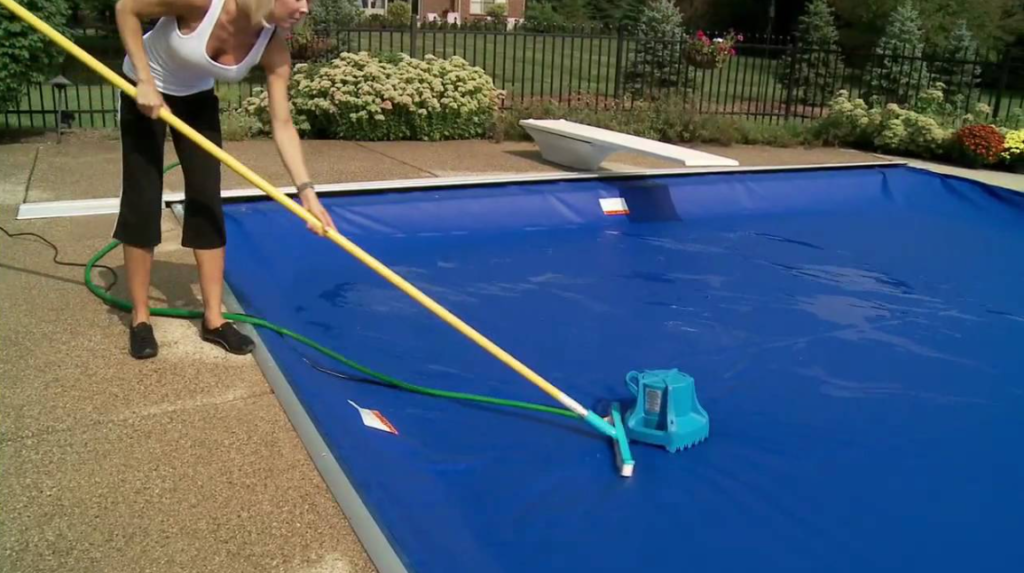
Ice and Snow on Pool Covers Remove snow from pool covers.
Just 10 inches of snow spread across your roof can weigh hundreds of pounds. And when that same snow gets wet with rainwater or freezes, its weight increases even more.
So the question naturally arises:
Can the pool cover collapse from too much snow?
Yes. But it all depends on what kind of cover you’re using, and how much snow you let pile up on it.
On that note, this is exactly why all winter pool covers need the support of your pool water.
By lowering your water to only 3-6 inches below the skimmer level, you give the cover enough room to expand before it touches the water. At this point, the water helps support your cover when it’s weighed down by rain or snow.
Of course, they will still sink and sag with a pile of weight. But don’t worry, winter pool covers are designed to work this way. And as long as you follow a few basic guidelines, you can keep your cover looking its best for years to come.
If you have an above-ground swimming pool, all that snow goes down the cover, pulling the pool walls toward the center. This can damage your swimming pool’s top rail, fence, and walls.
If you have an in-ground swimming pool, heavy snow can damage your cover.
If you have an expensive mesh safety, it’s important to make sure the ice doesn’t pile up and tear the cover. It can compete with cover anchors or even your pool.
If you have a cheap or generic plastic cover, chances are it will be destroyed if you don’t remove the snow quickly.
Let’s think about how much snow weighs. There are 7.48 gallons per cubic foot of water – that’s about 62.4 pounds of ice!!!
Wet snow – Assume wet snow equals 1 inch of rain or 5 inches of snow. That means you get a result of 62.4/5 = 12.5 pounds!
Light, Powdered Snow – This snow would be equal to 2.5 inches of water and 12 inches of ice, giving you 62.4/12 = 5.2 pounds! Thanks, Vicky!
After the snow melts it will turn into water, and now you will need a pool cover pump or siphon to get the water out of the cover. If you have a mesh safety cover, you will still need a pump to pump the water out of your overflow pool.
How to Remove Snow from Winter Covers
Here are some quick tips on how to properly remove snow from a pool cover. Remember, you don’t have to do this, but you risk losing the pool otherwise.
Use a long broom and remove the snow from the cover.
Do not use a shovel or anything with sharp edges as this can damage your winter cover by puncturing it and allowing dirty water to leak out.
As snow falls, use a broom to keep the snow from accumulating.
If the snow is light at first and you have a leaf blower, use it. If you use a leaf blower during snowfall, you won’t be moving all the weight of the snow.
Above ground pool
Your above-ground pool has strong walls and rails. They must contain hundreds of gallons of pool water. But that’s just it. They are designed to hold a certain amount of water and weight.
If you allow snow to accumulate on the pool cover, it will gradually add weight, putting more and more stress on the cover. And since the core is attached to the pool walls, this weight will also stress the top rail and walls, pulling them inward toward the center of the pool. They are not designed for that.
Let it get too long, and get too heavy, and the walls can collapse completely, leaving you with a huge mess to clean up and the expense of replacing the pool in the spring.
For in-ground swimming pool owners, the case is a little different. Heavy snow can damage the cover and cover, but you usually don’t need to worry unless you have two feet or more of snow on your cover.
That said, cheap plastic covers tend to damage more quickly and easily than expensive mesh or solid protective covers. But even more expensive covers can be damaged by heavy snowfall, causing cover anchors to dislodge, covers to crack, and more.
How do I remove snow?
Remember the old saying “A stitch in time saves nine?” This idea also applies to removing snow from your pool cover. The deeper and heavier the snow, the harder it is to remove. If you deal with less snow first, you avoid a situation where snow removal is very difficult. Here are some ways you can remove snow from your pool cover:
For light snow, use a pool vacuum with a brush attachment to reach the center of the pool, or use your leaf blower to blow away the snow.
To collect more, you’ll want to use a long-handled broom.
A core pump will remove the water as the snow melts. (We recommend using an electric pool cover pump with an automatic shut-off.)
Never use anything with sharp edges, such as a shovel. (A plastic shovel, with smooth edges, can be helpful, along with a long-handled broom.)
Regardless of the type of pool cover you use, it must be waterproof. The water or ice beneath it supports the weight of the water and ice that accumulates above it.
If the cover hangs above the water, all the weight hits the pool walls. This weight can potentially topple an above-ground pool or tear off pool anchors on an in-ground pool.
Keep the water level in your pool at least a few inches below the skimmer hole, and try to keep the pool pillow near the center on either side while floating in the water under the pool cover.
Also, monitor the water level in your pool, especially if you have a mesh cover that allows melted snow to flow into the water. Drain your pool as needed to maintain a level below the skimmer, and add water if necessary to ensure the pool cover does not hang above the water level.
These maintenance tips can help keep your pool safe during freezing temperatures even if there is no snow. When this happens, you have a few options when you’re ready to remove the snow.
Push the broom.
Push the ice off the cover and onto the edge of the pond with a push broom. If you can’t get to the center, brush the snow as far as you can so the snow melts to the sides and possibly into the pond.
A leaf blower
I use a handheld leaf blower for any snow that is light enough to blow away. A combination of a push broom to clear the edge and a leaf blower to get rid of the stuff in the middle works best for me unless the snow is thick and wet.
Pond salt
Using pool salt is a quick way to melt light snow quickly without dragging out a broom or leaf blower. Make sure the pool salt is specifically for pool use and not rock salt or commercial ice melt as you use it on sidewalks.
If you are using a mesh pool cover.
With a mesh cover, you will soon notice that the cover sags and stretches with the weight of the snow. This is because mesh covers are designed with a more flexible material.
Because of this, they can safely expand and even freeze with the weight of snow. And when they melt, they will return to their original form.
But there are limits. A mesh core can only stretch so much.
Both solid and mesh covers should be able to touch the water in your pool when they expand. So be sure to keep your waterline 3 to 6 inches below the skimmer level. (The mesh cover can extend a bit, so 6 to 9 inches is fine too).
So now that we’ve talked about why it’s important to remove snow from your pool cover, let’s get to the good stuff:
Dealing with different types of snow
Here’s what you need to remove it safely.
And, the best ways to remove snow from your pool cover
Underground pool
There is no risk of your inground pool collapsing under the weight of too much snow on the pool cover. But the cover itself can expand under that weight, which means it won’t cover your pool the way it’s supposed to.
Let’s be honest: high-quality in-ground pool covers can be expensive. Save yourself some money, and practice pool cover snow removal all winter long.
Protective covers can be even more expensive. If you have a more expensive mesh or solid pool safety cover, keeping it free of snow is even more important to prevent stretching and tearing. The weight can offset core anchors or even your pool. And you have to spend more money.
What if I have trouble removing snow?
With an above ground pool, if your pool cover already has a lot of snow it can be difficult to remove, even using a long-handled broom.
If you are unable to reach and remove all the snow (never walk on your pool cover to try to remove snow or ice), your best bet is to cut the cable into your pool cover. You read that right! Yes, you will have to do more facial cleansing in the spring. But at least you’ll still have an intact pool!
As the snow begins to fall, please contact us if you have any questions about snow removal from your pool cover. Our professionally trained staff will be happy to provide advice based on your specific situation. You can stop by any of our 4 locations or request a quote online today, if you’re thinking about installing a pool for next summer.
If you are using a solid core.
Solid pool covers rely heavily on their companion core pump for proper drainage.
Unlike mesh covers, solid pool covers have no holes for drainage. So when water or ice builds up on it, the only way to safely remove it is with a submersible core pump. These pumps draw water that collects in the center of the core and pushes it out for disposal.
Most concrete structures can safely support up to an inch of water, which is equivalent to about 10 feet of snow. That said, your job is to never let the snow pile up. And we’ll show you an easy way to do it soon.
Why do you need to remove snow from your pool cover?
The good news is that you don’t always have to remove snow from the pool cover. I have seen above ground ponds that drain below the skimmer level in the winter that lasts for years without de-icing.
However, the pool covers didn’t last as long as they could have. And if the owners had done a bit of snow removal after the worst storms, the pools themselves would have lasted longer.
Snow removal after a heavy snowfall can help protect your cover and prevent damage, especially to an above ground pool. Snow weighs a lot and can add hundreds of pounds on top of your winter pool cover. If the core doesn’t float or freeze on the surface of the water, it won’t last long under that kind of pressure.
In an above ground pool, the winter cover can pull from the sides and cause the sidewall of the pool to buckle, bend or even collapse with enough weight on top of it. In-ground pools won’t collapse, but if you have this type of swimming pool, the weight of the snow can tear the cover or pull anchors out of the pool or damage the vinyl liner.
Snow weighs about the same as it melts, even though it takes up much less space. Even a few inches of snow on a pool cover can weigh hundreds of pounds. If it rains and makes the snow wet and dense, the weight on top of the cover will increase. If it freezes in snow and piles more snow on top, it can be a recipe for disaster.
You cannot judge the weight based on the appearance of the ice. An inch of wet, heavy snow can weigh many times more than an inch of fluffy powder. Plan to remove it all and avoid speculation.
What to use to remove snow from a pool cover.
Do not use a shovel, or anything remotely sharp. This can damage and tear the cover, which is the opposite of what you want.
Instead, use a combination of these methods to remove snow from the pool cover:
Long broom to remove snow from cover
Leaf blower to remove light powder snow and prevent accumulation
Pool salt to melt light snow naturally (use only pool salt. Do not use rock salt for sidewalks and driveways).
A cover pump to remove water accumulation from snow
A waterproof heat cable to accelerate melting
Remove the ice from the cover before it causes damage.
Just keep a few tools on hand, and get the snow off the core before it becomes too heavy to remove.
Use a long, soft-bristled broom to remove new, hard snow from the core.
Use a pool cover snow removal tool for old, heavy snow. It is specially made for this purpose.
Do not use a shovel or anything with sharp edges. This may tear the cover.
If the snowfall is light, you can also use a leaf blower to keep it from accumulating.
If snow accumulates, but melts as the day’s temperature rises, you can use a pool cover pump to pump out the water and keep it from freezing when the temperature drops again.
Pool cover pump
A pool cover pump is needed to remove water that collects on top of concrete covers. You’ll need to remove snow more often with a solid cover or risk replacing it next season. When the ice melts, either leave the core pump on or carefully drain the water. An inch of standing water on the solid core is a lot.
Removing 5+ inches of snow from your pool cover
How to remove snow on an above ground pool cover
If you’re expecting a heavy snowfall, there are a few things you can do ahead of time to lighten the load on your pool cover:
Buy a waterproof heat cable, turn it on, and run it over the surface of your cover and around the pump.
This will melt the ice and create a drainage path for your core pump.
Sprinkle pool salt on the surface of the cover to prevent early snowfall.
Once the snow begins to accumulate on the cover:
Use a brush or leaf blower to remove buildup.
Leave the pump cover on to aid in thawing and drainage.
Sprinkle more pool salt on the remaining ice to speed up the melting.
The wrong ways to remove snow from your pool cover
Snow removal isn’t complicated, but there are certain methods you should never use to remove snow.
If you have one in your pool, don’t use anything that has the potential to tear your pool cover or vinyl liner. Avoid shovels, rakes, and any metal or sharp edges or points.
You might think you’d be careful, and you intend to be, but one miscalculation could mean spending hundreds of dollars to replace a chipped or torn pool cover.
If you tear your cover and need a new one, read my guide to the best pool covers.
Quick fix: Removing snow from your winter pool cover
As you now know, dealing with ice on your pool cover is very easy with the right approach. It’s a good mix of preparation and using the right tools for the job.
The key points of this post are:
- Keep your water line 3 to 6 inches below the skimmer level
- Sprinkle pool salt on your cover to speed up thawing and reduce freezing.
- Use a waterproof heat cable to speed up melting and improve drainage.
- Remove snow with a broom or leaf blower every 12 hours to reduce accumulation.
- Avoid using sharp tools like shovels or rakes – they will damage your cover.
- Leave your submersible core pump on to properly drain the water as the snow melts.
How to prevent ice from accumulating on your pool cover
Keeping snow off your pool cover seems easier than removing it after it accumulates. Unfortunately, preventing snow accumulation usually involves removing snow in small amounts rather than allowing it to accumulate.
When I’m expecting several inches of snow, I’ll go out and shovel snow at a few different times during the snowfall, like I do my front walk and driveway. I prefer to do a little at a time until a couple of feet are assembled.
If you keep these tips in mind, your pool can winterize and be ready to enjoy when summer returns. Be sure to read my guides on winter pool cover maintenance tips, winter pool maintenance, winterizing your pool, how to drain your pool cover, how to remove your pool cover, and how to prevent your pool cover from sagging.
Types of Snow
Light powdery snow
Remove powdered snow from the pool cover:
This is the most common type of snow you see in winter. It is a light and fast variety that sinks and crumbles as soon as you step into it. The postcard, picture-perfect snow that everyone wants to see on vacation.
But let’s talk about how it relates to your pool cover:
An inch of powdered snow weighs about 1 pound per square foot.
And a cubic foot (a perfect square, 12 x 12 x 12 inches) of snow weighs about 20 pounds.
This means a 10 x 30 swimming pool, with just 1 – 2 inches of snow, can easily lose over 450 pounds of weight on it.
Wet snow
Remove wet snow from the pool cover.
Wet snow weighs much more than regular powder snow.
And how much more?
Wet snow weighs anywhere from 2-5 pounds per inch more than normal snow. And the same goes for the frozen layers of ice.
This means 9 inches of powder snow, topped with an inch of frozen snow, weighs over 600 pounds.
Keep the Snow Mouser at bay
With just a few tools and a little vigilance, you can keep snow off your pool cover and protect your investment. Besides, who doesn’t love playing in the snow?
